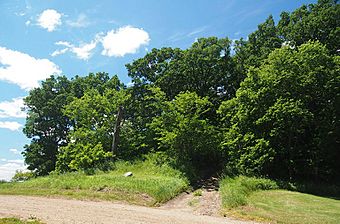Mountain Lake Site facts for kids
The Mountain Lake Site (also known as 21CO01) is an important archaeological site in Mountain Lake Township, Minnesota. It's a place where scientists have found many layers of old villages, showing how people lived there for thousands of years before Europeans arrived.
This site was once a hill that stood like an island in a lake. Today, it's part of a public park called Mountain County Park, managed by Cottonwood County. Because of its historical importance, the Mountain Lake Site was added to the National Register of Historic Places in 1977.
Contents
Ancient People at Mountain Lake
For about 3,000 years, different groups of Native American people lived and camped around what is now the dry Mountain Lake in Cottonwood County. This area has given us some of the oldest clues about human life in Minnesota. It shows us how a group of people lived quite separately from the main trading routes along the Upper Mississippi River.
Discovering an Ancient Village
In 1976, a team of archaeologists, led by Joseph Hudak, started digging at the Mountain Lake Site. They found signs of an ancient village. Using a method called radiocarbon dating, they figured out that the remains of a round house were about 2,100 years old. This makes it the oldest known dwelling ever found in Minnesota!
The amount of items found at the house site suggests it was used for only one winter. This means it's like a perfect snapshot of what life was like during the Middle Woodland period.
The Fox Lake People
Archaeologists have found pieces of decorated pottery at the Mountain Lake village that are similar to pottery found on other nearby islands. This tells them that the Mountain Lake village was part of what they call the Fox Lake focus. This group is named after a nearby village site on Fox Lake.
The Fox Lake people lived on islands in southwestern Minnesota from about 100 BCE to 850 CE. They were skilled bison hunters and made unique pottery. Their pots had wide openings and special patterns made by pressing cord-wrapped paddles into the clay.
Later Inhabitants and Trade
The Fox Lake people seemed to use certain tools, like specific types of hide scrapers, and pottery made with crushed shells later than groups living to the east. This suggests they stayed somewhat separate from the river trade routes used by the Oneota culture.
Some experts believe the Fox Lake group might be ancestors of the Crow and Hidatsa people, who later moved northwest into what is now central North Dakota. Over time, the Mountain Lake area was also home to Oneota groups. We know this from artifacts like crushed shell pottery and certain hide scrapers. The descendants of the Oneota include the Ho-Chunk, Otoe, Iowa, and Missouria tribes.
Mountain Lake's Recent History
In the 1870s and 1880s, Mountain Island was a source of wood fuel for the settlers who moved to Cottonwood County. By the early 1890s, people thought it would be a great spot for a summer resort. However, the land around the lake was swampy, making the island hard to reach.
Between 1905 and 1906, Mountain Lake was drained to create more farmland. Farmers then grew crops on the rich lakebed for many years. A road was built to make it easier to get to the former island.
Discovering More Artifacts
Interest in the hill grew in the 1950s when Sam Franz found flint arrowheads. His father owned the farmland around the old island. In 1956, excavations led by Lloyd Wilford uncovered a "deeply stratified village site." This means they found many layers of old village remains, showing that people lived there from the Late Archaic through the Middle Woodland periods. Seven years later, Wilford's further digs found similar arrowheads and pottery at nearby sites.
Protecting the Site
Because of these important discoveries, Mountain Park was placed on the National Register of Historic Places on June 4, 1973. To protect this important cultural site, any new buildings for camping were put on the side of the island that used to be underwater. Some of the items found during the digs were shown at the Science Museum of Minnesota in Saint Paul. A copy of the round house and some artifacts were also displayed at Heritage House in Mountain Lake.
Cottonwood County bought Mountain Park from the Franz family in November 1976. Major improvements began in 1979 with help from the Law and Conservation Fund. Roads, toilets, trails, a picnic shelter, entry signs, and a well were built.
Today, the undeveloped part of the former island at Mountain Park is a wonderful place to see wildlife and many kinds of birds. Visitors can enjoy nature in this quiet area, and there are campgrounds and picnic spots nearby.




